
MAY CONTAIN NUTS

Search Shorpy
SHORPY ART

Framed or unframed, desk size to sofa size, printed by us in Arizona and Alabama since 2007. Explore now.
Join and Share
Ad-Free Shorpy
Shorpy is funded by you. Patreon contributors get an ad-free experience.
Learn more.

Recent comments
- If You’re Like Me, Never
- U.S.A.
- S&P
- 1940 Zenith radio model 6G601
- Quality goes in before the name goes on!
- Snazzy skirt
- Carbon Arc Lamps
- Illuminate us
- I remember it well
- I can't prove it
- Complicated then, forgotten now
- Bryan-Stevenson
- Skinny is as skinny does
- How do you rest in peace
- Riding the footboards
- Alas, hidden from view
- Baldwin Diesels
- Exclusive pump
- Bananas, Oysters and Smokey Joe
- Details, Details
- What's that building to the left of the tower?
- Coal Barges
- Bromo-Seltzer
- Inner harbor
- The Basin
- What a headache!
- Giant stepladder?
- Yeah, it was cold
- Love those coats
- Link & Pin Days Remnant
Member Photos
The Shorpy
Print Emporium
Print Emporium
Search Shorpy
Search results -- 30 results per page
- Sport Touring: 1928
- San Francisco, 1928. "Franklin Sport Touring at Golden Gate Park." Latest entry in the Shorpy Pantheon of Forgotten ... that hat,
(The Gallery, Cars, Trucks, Buses, Chris Helin, San Francisco) ... Posted by Dave - 05/10/2015 - 9:23am -
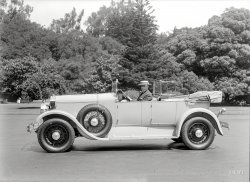
- San Francisco Briscoe: 1919
- ... Dossier of Dead-Ends. 5x7 glass negative by Christopher Helin. View full size.
China Beach Kozel got it right; that's the ... it may be Mile Rocks Light , which opened in 1906.
Touring Frisco in a Briscoe She was a buttoned up type of woman, but she had ... Posted by Dave - 01/11/2016 - 11:06pm -
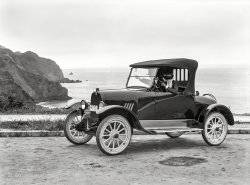
- Hop In, Honey: 19xx
- ... she's driving, and when? 5x7 glass negative by Christopher Helin. View full size.
"Ask the man who owns one" Packard. ... it belongs on a Rolls Royce.
1923-ish Packard Sport Touring All the salient parts match. The Buffalo wire wheels are a ... Posted by Dave - 04/12/2015 - 9:25pm -
![Hop In, Honey: 19xx From somewhere in San Francisco comes this undated, unlabeled photo of a lady in a fancy-looking phaeton with a glass headrest. Who can tell us what she's driving, and when? 5x7 glass negative by Christopher Helin. View full size.
"Ask the man who owns one"Packard. Not sure what year, but guessing late teens or so.
Hitchcock cameoI can't ID the car, but I can the big house across Jefferson Square Park at the upper left: it's the Fortmann Mansion at 1007 Gough, which in its decrepit state in 1958 portrayed the "McKittrick Hotel" in Alfred Hitchcock's Vertigo. Then a year later it was torn down. Behind the trees at the upper right, St. Paulus' German Evangelical Lutheran Church, built in 1893 at the corner of Gough and Eddy, also made a brief appearance in the film. It was destroyed by fire in 1995.
Circa 1928 Cadillac?Dual cowl phaeton/ oops i'll change that to a similar vintage Hudson; didn't know they had their own "flying lady."
HybridIt appears to be a 1924 Packard, but the hood ornament looks like it's from a 1928 Hudson. So they lost the Packard's rad cap and replaced it with the Hudson's?
PackardI am fairly certain that this is a Packard of about 1930/31.
The 'Glass Headrest' is in fact a windscreen for the rear passengers. It has fold-out 'wings' to deflect the rush of air, similar to the wings on the front windscreen. With the roof erected, it also provides a separation for the rear passengers from the lowly chauffeur up front.
1922–1933I think that this high-style cruiser is a 1922-1923 Packard Model 126 Sport Phaeton with custom body by Pullman Co.
The car is a 1929 Hudson The hood ornament is the only thing to give you a hint.
ID? MaybeAccording to Google "Images for hood ornaments guide", second picture in, it could be an Auburn between the years 1928 to 1931. That's based on the hood ornament, but photos of the actual car (compared to the Shorpy picture) don't really match.
Flying Lady.The hood ornament looks like it belongs on a Rolls Royce.
1923-ish Packard Sport TouringAll the salient parts match. The Buffalo wire wheels are a conversion—you can see the original holes on the brake drums. The radiator mascot, bumpers, spotlight, and side-mounted spare are contemporary accessories, or cadged from other cars. The rear windscreen may be the same, but with its wings folded in.
Edit I forgot to attach this photo earlier-- the radiator-shell shape, matching headlight bezels, the hood louvers and latch, windshield frame, belt moulding, long radiator neck, and access port for greasing the rear spring shackle, all point to the Packard. Their Model Series didn't line up exactly with the calendar, so the year model is not completely unambiguous.
Ask the Lady Who Owns OneSome model of Packard, maybe 1926 Touring? Should be plenty of experts out there.
I guessit's a 1928 Cord.
On the MarquePackard; note radiator top.
A Lincoln I'm ThinkinMaybe around 1925 and might be the Model L.
Excuse My Dust!It's a mid-1920s Packard, not a factory dual-cowl phaeton. The rear windscreen appears to be an add-on accessory. Back then it was quite popular with the higher end automobiles to accessorize the hood ornament with something other than the factory job. Packards at the time came with Motometers.
Hudson Hood OrnamentThe hood ornament is the "winged sea goddess" radiator cap from a late 1920s Hudson:
ModifiedPlacing the model year as 1924 due to the drum headlights but the spare wheel mounting seems to be after-market as it is not recessed into the fender. Four wheel brakes narrows the field but positive as a Packard would be iffy.
Car IDI'll say it's a 1923 Packard SportPhaeton.
I agree with WatchwayneIt's a Packard. Around '23. The radiator cap has been swapped out and I don't blame them. This cap is beautiful. If you look at the radiator, the top has a curved slope that was found on the Packards. Above the running board towards the rear, you can find an oval access hole. These items are the same on both vehicles.
Kind of a jalopyA little hard-used. Top is missing, running board is distorted. This could have been taken in the late 30s or even the 40s.
[The license tag, tires, and fact that the photo is a 5x7 glass negative, point to an earlier time frame. - Dave]
License to dateI'm going with 1927.
Special KNote the "K" tread design and monogram (which may be the reason the picture was taken -- retrofit your ride with modern Kent Balloon tires).
1927?I am interested in the reasons why tterrace concludes for 1927.
In the reverse picture detail I only see:
1 - 99[.-...]
19 CAL[IFORNIA] ..
So why 1927? Tterrace, please make me wise.
[The plate format shown in the photos in my comment was used only in 1927 and 1928; 1927 was a guess based on what seems like thicker characters in that year. -tterrace]
(The Gallery, Cars, Trucks, Buses, Chris Helin, San Francisco)](https://www.shorpy.com/files/images/SHORPY-310-01.thumbnail.jpg)
- Predator: 1919
- San Francisco circa 1919. "Cole touring car at Stow Lake, Golden Gate Park." Upholstered in alligator. 5x7 glass negative by Christopher Helin. View full size.
Fabrikoid Ferocious predator of the Nauga.
... Places.
(The Gallery, Cars, Trucks, Buses, Chris Helin, San Francisco) ... Posted by Dave - 12/23/2014 - 12:21pm -
![Predator: 1919 San Francisco circa 1919. "Cole touring car at Stow Lake, Golden Gate Park." Upholstered in alligator. 5x7 glass negative by Christopher Helin. View full size.
FabrikoidFerocious predator of the Nauga.
No wonderI had never heard of this brand of car before. Regardless of the choice of "finish", that is one ugly vehicle. Anyone know how many of these were made?
Questionable coveringNevertheless, a handsome automobile. I particularly like the lines of the roof and rear windows - rather modern for the times.
Whatever happened to the manufacturer?
A Wrap and a RapRush1959 pegs it as a "wrap". When we weren't doing commercial and Air Force planes, my very last business included a "sideline" of vinyl wraps for everything from motorcycles to 18-wheelers.
At the last industry convention in Las Vegas, one could watch a pair of brand-new Rolls Royces being wrapped in everything from fake snakeskin to alligator and whatnot, over and over, for five days. (A travesty, really.)
This particular job would have my customer coming back in a very bad mood and all the profit on the job would be eaten up by the labor and materials to redo sections. Those bubbles on the left front fender and that detaching flap above the leaf spring this side of the right front wheel would get a do-over.
[Those "bubbles" are screw heads. -Dave]
Whenever I had a customer come in for a wrap, I always thought, "There's no accounting for taste", but the grumpy accountant loved the results.
Whenever I see one of our wraps rolling down the road, I'm surprised to see it intact these many years on but the prevailing emotion is joy that my old shop is now a funeral home and I'm not there (yet).
Helluva Long HoodJust imagine crashing with that vehicle - the driver wouldn't be there until some minutes had passed.
WowI thought the caption meant the SEATS were upholstered in alligator, not the entire car. Oddly enough the seats are cloth, guess they didn't want to get too carried away. It certainly makes a statement, I'm not sure what the statement is.
The gift that keeps giving -- and takingFor the man who has everything.
AlligatorYou want alligator because it doesn't mind getting wet.
Fabric covered carsLikely to hold up about as well as vinyl covered automobile roofs did in the 1970s, which were a stylish but rust-attracting option available on just about every make from lofty Rolls Royces to humble Pintos.
SkinnedLeather coated for your driving pleasure. Don't drive it anywhere in Africa unless you want a wildcat to mate with it.
Luxury V8By 1919 Cole had dropped all 4 and 6 cylinder vehicles and were making only big V8s. Roadsters, touring, it didn't matter -- all had V8s.
Not a 'Touring Car'It's a body style known as a "Sedanca DeVille."
Color/Covering on car?Is that a leather look? Was that common?
[We've seen an alligator-finished auto from this period before. As mentioned in the comments, the material used was Dupont Fabrikoid. -tterrace]
Fabrikoid BrochuresArchive.org has two DuPont brochures for Fabrikoid, printed in 1911 and 1930. Below is a page from the 1911 edition. The entire brochure can be accessed here.
The 1930 brochure can be accessed here.
Red Green says:"Wrinkles in your Duct Tape is a sign of poor workmanship". The same can be said for this travesty.
That's a wrapThe original vinyl body wrap! I think that thing rusted to bits in no time.
Well really,why not ?
Marque ProductionCole Automobiles were assembled in Indianapolis, Indiana from 1909 to 1925 with prices in 1919 ranged from $2,595 to $3,795.
Total Cole production numbers vary depending on the source. Hemmings stated in 2013 that 35,267 Coles were produced, but many other sources list a total production of 40,700. Cole production in 1919 is listed as 6,225 in the book "Cars" by Adriana Brain, but Hemmings claims that the peak of production was 1916 with 5,160 made.
There is no doubt that in the post WWI depression Cole vehicle production dropped. During 1922 Brain states that 1,722 Coles left the factory. Production dropped further in 1923, and late in 1924 production ceased. These last cars were 1925 models (607 produced). Joseph Cole chose to liquidate his company early in 1925. He died on August 8, 1925 just before the liquidation was finalized.
Before company ended production a 1924 Cole paced the Indianapolis 500. Cole was friends with Speedway founder Carl Fisher, and Fisher decided to honor his friend by giving Cole's company the pace car responsibilities. Cole engineer Louis 'Lew' Pettijohn drove honorary race referee (judge) Henry Ford around the track in the pace car.
Approximately 70 Cole cars are known to still exist. Both the Cole Motor Car Company factory and his Indianapolis home are listed on the U.S. National Register of Historic Places.
(The Gallery, Cars, Trucks, Buses, Chris Helin, San Francisco)](https://www.shorpy.com/files/images/SHORPY-177-02.thumbnail.jpg)
- Reduced Prices: 1924
- ... Ness & O'Farrell." 5x7 glass negative by Christopher Helin. View full size.
Harley Earl Definitely custom bodied. Harley ... Made in the Shade This Cadillac, probably a Type V 63 touring car, has an accessory fixed, but removable, hardtop. They were ... Posted by Dave - 07/17/2016 - 4:42pm -
![Reduced Prices: 1924 San Francisco circa 1924. "Don Lee Cadillac agency -- N.E. corner Van Ness & O'Farrell." 5x7 glass negative by Christopher Helin. View full size.
Harley EarlDefinitely custom bodied. Harley Earl was the manager of the Don Lee Cadillac Custom Body Shop during this period. They had a good market selling custom bodied Cadillac to the Hollywood elite.
Four Door Hardtop Who knew there was Cadillac 4-door hardtop before 1956? Very interesting, I wonder if that was factory or custom bodied.
Made in the ShadeThis Cadillac, probably a Type V 63 touring car, has an accessory fixed, but removable, hardtop. They were developed and popularized by Murphy Coachworks in Pasadena, California. They became generically known as "California Tops" regardless of by whom or where they were made
1924 Cadillac Town BroughamMy guess is that this gorgeous vehicle is a Town Brougham model.
Usually the Brougham has a half roof leaving the driver in the sun or rain. (Same proportions in the rear as this).
This variation seems to have opted for a full roof.
There is no such body style as a full roof Brougham in the 1924 Cadillac advertisements. But clearly you could special order one because here it is.
[This is a touring car with what was generally known as a "California top," an aftermarket or dealer-installed accessory that was a cheaper alternative to a closed car. - Dave]
Very expensive (for the time)Below is a list of the 1924 Cadillac prices. Notice that the Touring car was the lowest priced (adding the roof probably added a few hundred). Today we could probably buy that with pocket change.
Style No. Body Type Seating Price Weight
NA 4-dr Touring 7 $3085 1945 kg
NA 4-dr. Phaeton 4 $3085 1909 kg
NA 2-dr. Roadster 2/4 $3085 1905 kg
5490 2-dr. Victoria 4 $3275 1991 kg
5380 2-dr. Coupe 2 $3875 1941 kg
5280 2-dr. Coupe 5 $3950 1986 kg
5270 4-dr. Sedan 5 $4150 2036 kg
5290 4-dr. Landau Sedan 5 $4150 2036 kg
5460 4-dr. Imperial Sedan 5 $4400 2091 kg
5260 4-dr. Suburban 7 $4250 2073 kg
5310 4-dr. Imp. Suburban 7 $4500 2109 kg
5470 4-dr. Sedan 7 $3585 2095 kg
5300 4-dr. Limousine 7 $4600 2109 kg
5370 4-dr. Twn. Brougham 7 $4600 2059 kg
(The Gallery, Cars, Trucks, Buses, Chris Helin, San Francisco)](https://www.shorpy.com/files/images/SHORPY-1007.thumbnail.jpg)
- Nomobile: 1920
- ... Shorpy photo found here .
[Both vehicles are open touring cars with "California tops" -- aftermarket accessories that would be ... sure that this vehicle is a 1922 Winton Six Model 40 Touring Car.
[Ding ding ding! I think we have a winner! - Dave]
... Austin?
(The Gallery, Cars, Trucks, Buses, Chris Helin, Dogs, San Francisco) ... Posted by Dave - 11/18/2017 - 11:59pm -
![Nomobile: 1920 UPDATE: Resident pantomath tterrace puts us at Jefferson Square Park, while Shorpy member 426hemi identifies the car as a 1922 Winton Six Model 40. Well done!
The place: San Francisco circa 1920. The tires: Goodrich Silvertown Cords. That's about all we can say about this 5x7 glass plate, whose negative sleeve is devoid of any caption information. We leave it to you to fill in the blanks. View full size.
Maybe Winton, but which model.This car has been the subject of discussion on the aaca forum pages. It would seem to be a Winton but the car in the picture submitted by 426hemi is larger. It has 34 hood louvres vs 30 on the mystery car. Note also the hood is obviously longer as you can see the second handle. I have several references which mention Winton and none agree re which model is which and in which years there were two wheelbase lengths.
[The photo below of a Winton Six, model unknown, was added by me. Comparing it to the large photo proves nothing, other than to show that both cars are Winton Sixes. - Dave]
Jefferson SquareThis is at Jefferson Square Park, previously seen here, in which you can see the Fortmann Mansion, used as the McKittrick Hotel in "Vertigo." Below, the imposing edifice farther up Eddy St. in the current shot is seen in this 1906 photo when the park was filled with post-earthquake and fire refugee tents (click to enlarge).
Chalmers?Windshield looks like this earlier Shorpy photo found here.
[Both vehicles are open touring cars with "California tops" -- aftermarket accessories that would be poor clues as to the make of the car. - Dave]
Vehicle isA Paige.
[A Paige of this vintage would have angled hood louvers, as well as the word PAIGE on the hubcaps. So keep guessing. A good clue might be the "mouse hole" lubrication port over the running board. - Dave]
No Photographer?Interesting! For an almost straight-on photo there is not a reflection of the photographer.
I'm 99% sure that this vehicle isa 1922 Winton Six Model 40 Touring Car.
[Ding ding ding! I think we have a winner! - Dave]
Just a guessAustin?
(The Gallery, Cars, Trucks, Buses, Chris Helin, Dogs, San Francisco)](https://www.shorpy.com/files/images/SHORPY-1242.thumbnail.jpg)
- A Couple of Cads: 1919
- San Francisco circa 1919. "Cadillac touring car and sedan." Touring a veritable wonderland of chalk art. 5x7 glass negative by Christopher Helin. View full size.
Yes, Good Riders? That appears to be the ... Posted by Dave - 12/11/2015 - 10:21pm -
![A Couple of Cads: 1919 San Francisco circa 1919. "Cadillac touring car and sedan." Touring a veritable wonderland of chalk art. 5x7 glass negative by Christopher Helin. View full size.
Yes, Good Riders?That appears to be the message displayed within the diamond-shaped decal on the passenger side windshield.
What, pray tell, would be the meaning of that display?
[It's "Yes Good Roads," a slogan in support of a 1919 California ballot proposition for a $40,000,000 bond issue to fund state highway construction. It passed. -tterrace]
Board FenceThis is the definitive modelbuilder's reference for a board fence. They were common within my memory, and my wife remembers them too. You still see a few in old western PA towns.
Note that some kid dragged chalk the length of the fence.
Reproducing the faded "HORP" sign on the fence between the cars would be a modeling challenge.
SlummingNot the most Cadillacky of neighborhoods.
LocationAre you sure this isn't Oakland? Those two beauties look like they're just about to try to merge, the hard way.
StandoutsStrange to see these two elegant, up-scale vehicles placed in a very humble neighborhood (with its ubiquitous chalk markings) as opposed to the previous auto portraits "uptown".
GlossyI always admired the top coat finish on these cars. A mirror finish not displayed these days.
New cars but old tiresCan't help but notice how worn the tires are on these apparently new vehicles. The front ones on the car on the right don't even match. I don't think that "optional" bumper on the coupe is really going to stop much. It's interesting to note that even on high end cars like Cadillacs there are rows of rivets along the edges of the hood. Auto designers today go out of their way to hide fasteners to the point it is sometimes difficult to figure out how to remove a piece for repair.
Twins?Are the two gents in the touring car twins?
CadillacsThe car on the left was previously shown here. This is one of the two touring cars models Cadillac sold in 1919. Both models were on the same 125 inch wheelbase, but one had jump seats and sat seven instead of four passengers. Both were priced at $2,805, and the standard colors were Cadillac Blue with black trim. The dealer license plate indicates the car was being sold by Don Lee Cadillac shown here.
The second cars looks like a Convertible Victoria. The side window glass and center door post could be removed to create a semi-open car. This car was also on the 125 inch wheelbase and cost $3,205.
(The Gallery, Cars, Trucks, Buses, Chris Helin, San Francisco)](https://www.shorpy.com/files/images/SHORPY-825.thumbnail.jpg)
- Cadillac Caliphs: 1932
- ... Don Lee handing over the keys to a V-12 Cadillac touring car.
San Francisco, 1932. "Cadillac agency, NE corner Van Ness ... Masonic potentates. 5x7 glass negative by Christopher Helin. View full size.
Man of Many Achievements Don Lee was the ... Posted by Dave - 02/13/2015 - 1:12pm -
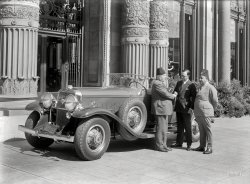
- The Outing: 1919
- ... be out of gas!"
San Francisco circa 1919. "Maxwell touring car." Transporting its tourists on what looks to be a chilly day. 5x7 glass negative by Christopher Helin. View full size.
Gas or no gas First base is out of the ... Posted by Dave - 07/12/2015 - 5:35pm -
![The Outing: 1919 "Goodness, Isobel -- we seem to be out of gas!"
San Francisco circa 1919. "Maxwell touring car." Transporting its tourists on what looks to be a chilly day. 5x7 glass negative by Christopher Helin. View full size.
Gas or no gasFirst base is out of the question with those suits of armor.
Test drive?Maybe it's the angle, but it appears the man is a passenger...and the front plate on the car is a dealer plate. It makes me wonder if they were doing a test drive--or perhaps a spouse is the one taking the picture and the ladies wanted to show off their stylish duds.
I remember my grandmother wearing shoes like those for as long as she could get about. I'm not a clothes horse but I'd love to go back for a day to wear the hat and coat of the lady on the left. Just stunning!
[The Christopher Helin photos were taken for his automotive articles in the San Francisco Examiner, generally using cars from local dealers. -tterrace]
Could Be“The coldest winter I ever spent was a summer in San Francisco.”
The coolest thing Mark Twain never said.
RoadIt appears they have more problems than being out of gas. It seems the road kinda disappears.
[The rather artificial look of the "rocks" suggests this was taken in Golden Gate Park. -tterrace]
Oh, baloneyThose are some smooth front tires
Front Sprocket?Can any automotive historians explain the purpose of the toothed sprocket that can be seen between the spokes of the right front wheel hub? Perhaps the speedometer drive?
Stewart SpeedometerAs Goats Of Venus suggests, the visible gear and sprocket on the front wheel are indeed part of the drive mechanism for a speedometer—most likely a Stewart model (later Stewart Warner). A very good discussion with pictures of fitting one on a Ford Model-T can be found here.
SpeedoThe sprocket (actually, a gear) is part of the speedometer drive. The smaller gear, which can be seen in the photo, drove the angle drive which, in turn, spun the cable that connected to the speedo head, inside the car. In the early cars, like this Maxwell, the cable was a small inked chain that rode inside of an armored outer sleeve. Most cars used Warner speedometers at the time
(The Gallery, Cars, Trucks, Buses, Chris Helin, San Francisco)](https://www.shorpy.com/files/images/SHORPY-360-01.thumbnail.jpg)
- The Rolling Dead: 1921
- San Francisco circa 1921. "Dorris 6-80 touring sedan at Spreckels Mansion." Latest entry in the Shorpy Compendium of ... Dorris would be extinct. 5x7 glass negative by Christopher Helin. View full size.
Top Of The Hill And Behind The Hedgerow One ... Posted by Dave - 05/13/2017 - 1:24pm -
![The Rolling Dead: 1921 San Francisco circa 1921. "Dorris 6-80 touring sedan at Spreckels Mansion." Latest entry in the Shorpy Compendium of Cretaceous Conveyances; by 1924 the Dorris would be extinct. 5x7 glass negative by Christopher Helin. View full size.
Top Of The Hill And Behind The HedgerowOne does not get the full understanding of this being at the top of a hill until seeing:
https://sf.curbed.com/2014/11/25/10018636/behind-the-hedges-and-inside-t...
And the historic view will never be seen again until the fortress-like privacy hedgerow is removed.
https://sf.curbed.com/2014/7/31/10065838/here-now-a-photo-tribute-to-dan...
An Impressive BeastCan anyone say what those two small panels on top of the hood are for?
Putting on AirsThe doors on the hood are vents, as noted by Shorpy reader Zcarstvnz in an earlier Dorris post. The little compartment below and in front of the driver's door housed an air compressor for supplying air to the tires.
Ready for our close-upsJust curious....We have seen many pictures of new cars from various manufacturers in the 20's and 30's shot in San Francisco. We tend to think of car production back then happening in the east, especially Detroit. Did these early car manufacturers ship cars to San Francisco for promotion shoots or did California have a thriving car industry we never heard about?
[Christopher Helin wrote a continuing series of automobile feature articles for the San Francisco Examiner, illustrating them with these photos of dealer and owner vehicles. -tterrace]
Yes, We Can Be FrankThe car was registered to Mrs. Mattie A. Frank (1877 - 1962) of 2555 Webster Street, San Francisco. Her husband was Albert Frank the president of S. H. Frank and Company who was being driven around in a Locomobile Town Car at this time.
S. H. Frank and Company sold shoe supplies along with shoe findings, and they were also tanners and leather dealers. The firm is still in business today (founded 1857).
(The Gallery, Cars, Trucks, Buses, Chris Helin, San Francisco)](https://www.shorpy.com/files/images/SHORPY-1169.thumbnail.jpg)
- Big Six: 1921
- ... Francisco or vicinity circa 1921. "Studebaker 'Big Six' touring car." Cigar-chomping Army brass at the wheel. 5x7 inch glass negative by Christopher Helin. View full size.
Big Cig for the Big Six.
Not factory ... Posted by Dave - 07/13/2022 - 10:33am -
![Big Six: 1921 San Francisco or vicinity circa 1921. "Studebaker 'Big Six' touring car." Cigar-chomping Army brass at the wheel. 5x7 inch glass negative by Christopher Helin. View full size.
Big Cigfor the Big Six.
Not factory issueThere's a spotlight mounted along the driver's side window. It's odd they photographed the car when it was so dirty, especially if for military use.
Side curtains My God, what a tremendous hassle side curtains must have been when skies started to threaten. Pull over, dig them out from wherever they were stored, sort them out, make sure you didn’t have the driver’s side rear when you wanted the passenger side, and how sweltering it must have been in a summer storm under all that black oilcloth, and how frigid in the winter. I’m sure this guy just had to shout and six enlisted men would appear from someplace and take care of it.
Accident waiting to happenThat front tire might or might not be a retread, but in any case, it is coming apart.
Nice ride!What a classic, but what a pain it must have been to put air in the tires! I wonder what the small round opening just ahead of the rear wheel is for?
[Access to the leaf spring front shackle grease fitting. - Dave]
Thanks!
Side CurtainsStudebaker had a system called "Jiffy Curtains" that worked by suspending the top of each curtain to a cable that ran along each side of the top from front to back. Just unclip the bottom and side edges and fold up the curtain like an accordion, then slide towards the rear like a shower curtain. There was a flap over the rear window where it would all be stored.
Not An Attractive CarThis model must have not lasted for long. Sorry to say, it is not at all attractive.
[Sorry to say, 1918, 1919, 1920, 1921, 1922, 1923, 1924, 1925, 1926, 1927. - Dave]
Open cars v closed carsThe hassles with putting up those side curtains was one of the reasons that by 1925 closed-bodied cars outsold open-touring cars in the United States.
Trapped I wonder what it took to get out of the backseat with those curtains in place?
(The Gallery, Cars, Trucks, Buses, Chris Helin, San Francisco)](https://www.shorpy.com/files/images/SHORPY-1723.thumbnail.jpg)
- Star Car: 1922
- ... to FS and WL. 5x7 inch glass plate by Christopher Helin. View full size.
Sleek The omission of exterior door handles ... to directly compete with Henry Ford's Model T. The Star Touring Car cost $348 without a self-starter or demountable rims for the tires. ... Posted by Dave - 09/18/2014 - 2:03pm -
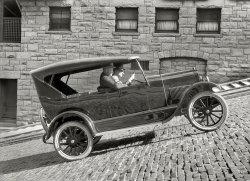
- The Black Hand: 1920
- San Francisco, 1920. "Standard Eight touring car." Today's entry in the Shorpy Digest of Dingy Digits. 5x7 glass negative by Christopher Helin. View full size.
Fort Mason The touring car is parked on Van ... Posted by Dave - 11/27/2018 - 3:50pm -
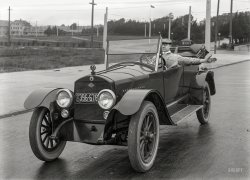
- Milady's Marmon: 1919
- ... Geary & Post." 5x7 glass negative by Christopher Helin. View full size.
Another example The lady's muffled appearance ... Note the speaking tube by the chauffeur.
Car ID The touring car in the background is a Briscoe.
Can You Hear Me Now? The ... Posted by Dave - 05/08/2017 - 8:17pm -
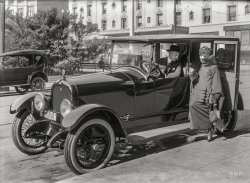
- Expect Great Things: 1923
- ... on the "California top." 5x7 glass negative by Christopher Helin. View full size.
2-wheel go, 4-wheel stop Hey, it looks like ... called a "demi-sedan" It could be stripped down to make a touring car in the summer and panels added to create a semi-snug semi-sedan for ... Posted by Dave - 02/13/2015 - 1:57pm -
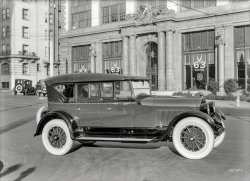
- Formal Phaeton: 1921
- San Francisco circa 1921. "Studebaker Special Six touring car at Spreckels Mansion." 5x7 inch glass negative by Christopher Helin. View full size.
Sliders Served Here A perfect example of how ... Posted by Dave - 09/14/2017 - 10:28am -
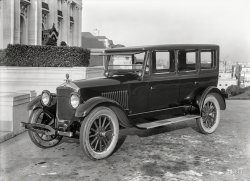
- Caught in Passing: 1920
- San Francisco circa 1920. "Chalmers touring car on Van Ness Avenue." At F.J. Linz Motor Co., your Scripps-Booth ... streetcar squeezing by. 5x7 glass negative by Christopher Helin. View full size.
Multi makes This dealer also sold ... photographs.
(The Gallery, Cars, Trucks, Buses, Chris Helin, San Francisco, Streetcars) ... Posted by Dave - 11/21/2015 - 11:58am -
![Caught in Passing: 1920 San Francisco circa 1920. "Chalmers touring car on Van Ness Avenue." At F.J. Linz Motor Co., your Scripps-Booth dealer. With a streetcar squeezing by. 5x7 glass negative by Christopher Helin. View full size.
Multi makesThis dealer also sold Simplex-Crane cars listed below the Scripts-Booth name and on the second floor is the radiator image and name of the National car. Prices start probably with Scripts-Booth followed by Chalmers, National and Simplex-Crane (a huge expensive car) in that order.
Building on the left The building on the left is still there. The Linz building has been replaced by a hideous square box that is boarded up in the Google Streetview ...
[Though unrecognizable now, it's actually the same building, originally built in 1913 -tterrace]
... but its grand neighbor across Cedar St. is there. It is the Concordia Argonaut Club:
founded in 1864 by Levi Strauss and famous members like Haas, Dinkelspiel, Sutro, Lilienthal, the club was originally composed of only Jewish men, it now admits non-Jews and women. The Concordia-Argonaut Club is one of the premier private clubs in the United States.
Things to Ponder"Is it worth a bent fender to knock that oaf out of the way?"
I know -- the car's not moving or there's a depth of field issue, but it certainly looks as if Mr. Pedestrian is not long to remain in an upright position.
Van Ness - The Auto 'Miracle Mile'In the early 60's Van Ness used to harbor the majority of S.F. auto dealers.
Gotta askBetween the front of the streetcar and the radiator of the automobile we see a rectangle of glass with a Scripps-Booth pennant hanging in the window. The car that we see in the glass is the reflection of our Chalmers touring car, right? And we also see the blurred arm of the man outside on the pavement walking towards the unsmiling driver?
[It's not a reflection. The car is on the street in front of the building. -tterrace]
Well, I'll be. Thanks, tt. Just when I thought I was getting the hang of figuring out photographs.
(The Gallery, Cars, Trucks, Buses, Chris Helin, San Francisco, Streetcars)](https://www.shorpy.com/files/images/SHORPY-779A.thumbnail.jpg)
- Skid Row: 1924
- San Francisco circa 1924. "Star touring car with four-wheel brakes." The same venue (and graffitists) as our ... first car My grandfather's first car was a Star touring car, I think the same year as this one. The Star was General Motors' ... long either.
(The Gallery, Cars, Trucks, Buses, Chris Helin, San Francisco) ... Posted by Dave - 01/19/2015 - 9:59am -
![Skid Row: 1924 San Francisco circa 1924. "Star touring car with four-wheel brakes." The same venue (and graffitists) as our previous Star sighting. And more evidence that smoking is hazardous to your health. 5x7 glass negative. View full size.
No spray paintSo we'll just carve our initials in stone.
Skateboarding ramp? I'm curious as to what's that between the sidewalk steps and the road. Thanks in advance.
[A less ambitious sidewalk. -Dave]
Just as shiny as the previous postingI have never had a car this shiny. I will never have a car this shiny. I am beyond jealous. Truly, a shining Star.
Grandfather's first carMy grandfather's first car was a Star touring car, I think the same year as this one. The Star was General Motors' response to the cheap car market opened up by the Model T.
Time MachineAfter three years of running over the other volunteer smokers the Star comes out with four wheel brakes. This is a 1927 model made by Durant Motors, not GM.
[It's a 1924 model. Below, an ad from May 1924. - Dave]
I've had a lot of bad brakesI did a lot of research on this and found nothing about four wheel brakes in any Star catalog or service manual until 1928. The service manual covers them for the first time. The "Standard Catalog of American Cars" has 1927 as the starting date. After seeing what you came up with I found this article which explains it. Four wheel brakes were available in California for a extra cost. I'm sure the people of San Francisco were happy to have them along with grandpa Geiko.
Nitrocellulose LacquerThe shine is due to the use of nitrocellulose lacquer, still used on guitars and similar interments, but illegal in automotive paint for some time due to its high toxicity. Back in those days the shine did not last very long either.
(The Gallery, Cars, Trucks, Buses, Chris Helin, San Francisco)](https://www.shorpy.com/files/images/SHORPY-196-01.thumbnail.jpg)
- Wide-Eyed: 1920
- San Francisco circa 1920. "Pierce-Arrow Model 31 touring car." Latest chapter in the Shorpy Anthology of Antique Autos. 5x7 ... is a 1933.
I've Been Wondering On these old touring bodies, the front seat shells seem to be integral with the body; how ... housings.
(The Gallery, Cars, Trucks, Buses, Chris Helin, San Francisco) ... Posted by Dave - 01/08/2017 - 11:47am -
![Wide-Eyed: 1920 San Francisco circa 1920. "Pierce-Arrow Model 31 touring car." Latest chapter in the Shorpy Anthology of Antique Autos. 5x7 glass negative. View full size.
A paradox and a preferenceOne may still find examples of the Pierce-Arrow without the characteristic fender-mounted headlamps.
For several years early in the marque's history, Pierce-Arrows sold in their state of manufacture (New York) were required to be fitted with conventional free-standing headlamps because the NY vehicle code prohibited P-A's trademark flush lamps.
Likewise, customers who preferred a more conventional "face" on their cars could order their P-As with conventional headlamps and the manufacturer would accommodate. I am not sure when that policy ended, if indeed it did, but I have never seen a P-A from the '30s with anything but the "normal" P-A headlamps.
Pierce Arrow DealershipThe building directly across street on Polk is the old Pierce Arrow dealership from when the neighborhood around that part of Van Ness Avenue up the street was Auto Row. Today it is a homeless shelter.
Paradox FoundHere are two photos of 1930s Pierce Arrows with regular headlights. The blank and white photo shows a 1930 model, and the red car is a 1933.
I've Been WonderingOn these old touring bodies, the front seat shells seem to be integral with the body; how was the seating adjusted for different-sized drivers? Did anyone not average-sized just have to tough it out?
Frog eyesThe story behind the distinctive Pierce-Arrow headlights can be found here.
TenderloinThis photograph was taken at the corner of Geary and Polk. The building still exists and looks exactly the same.
Door locks on a tent?Are those little silver posts locks?
[They're latches for opening the doors. - Dave]
LoveThose distinctive P-A headlight housings.
(The Gallery, Cars, Trucks, Buses, Chris Helin, San Francisco)](https://www.shorpy.com/files/images/SHORPY-1075.thumbnail.jpg)
- Sidewalks Are for Sissies: 1920
- ... can Street View this. 8.5 x 6.5 negative by Christopher Helin. View full size.
Forget the location Feast your peepers on ... be proven by the accompanying photo, which shows the new touring model speeding up a difficult and roadless grade.
Article does not ... Posted by Dave - 09/16/2014 - 9:17am -
![Sidewalks Are for Sissies: 1920 San Francisco circa 1920. "Franklin car ascending steep grade." Bonus points if you can Street View this. 8.5 x 6.5 negative by Christopher Helin. View full size.
Forget the locationFeast your peepers on that paint job!
From the ChronicleSan Francisco Chronicle, Aug 29, 1920; pg. A7
City Driving Art In Itself
Driving in Country Far Different in Method, Expert Holds
Franklin Car Proves Power
The Franklin car has a lot of power, as will be proven by the accompanying photo, which shows the new touring model speeding up a difficult and roadless grade.
Article does not mention the location of the hill.
Vallejo StreetThe 900 block of Vallejo Street.
View Larger Map
Nice upgradeI don't know if it's unusual or not in the City, but I do find the squeezing in of a garage there rather ingenious.
[Very common in older San Francisco homes. -tterrace]
$an Francisco!Those beautiful old stacked homes in San Francisco now go for millions!
About those Bonus PointsI think tterrace deserves them for fast work and a great view of the lovely houses.
[Bonus points are included with the Shorpy Inc. Christmas bonus, as per corporate policy, redeemable in turkey or ham. - Dave]
Thanks Dave. Does that come with cranberry sauce?
Blood, Sweat and TearsWhat goes up ... must come down.
(The Gallery, Cars, Trucks, Buses, Chris Helin, San Francisco)](https://www.shorpy.com/files/images/SHORPY-GN-Helin-Franklin-2.thumbnail.jpg)
- Que Sera, Sera: 1922
- San Francisco circa 1922. "Dorris touring car at Shreve & Co." Latest entry in the Shorpy Parade of Archaic Chariots. Photo by Christopher Helin. View full size.
Well-known location Little has changed, down ... a Dorris.
(The Gallery, Cars, Trucks, Buses, Chris Helin, San Francisco, Stores & Markets) ... Posted by Dave - 01/21/2015 - 2:30pm -
![Que Sera, Sera: 1922 San Francisco circa 1922. "Dorris touring car at Shreve & Co." Latest entry in the Shorpy Parade of Archaic Chariots. Photo by Christopher Helin. View full size.
Well-known locationLittle has changed, down to the streetlamps, although I suspect the prices are a bit different.
Archaic chariots!Classic. And they probably thought they were the best.
Shreve & CompanyCorner of Post and Grant, a block down from Union Square.
View Larger Map
A Perfect Exampleof why we refer to the trunk as a "trunk."
Almost Over My Headbut on my second read I got the "Que Sera, Sera" reference. A title well written.
Neat history on this bldg.right here.
YuchNothing to do with the picture you posted, but I had to clean off the remains of my breakfast from my keyboard. Any chance of making Shorpy a paid-site so we can avoid advertisements like this?
[We'll let you know as soon as your check arrives! - Dave]
The future's not ours to seeSadly, 1923 would be the last year of production for the costly and hand-built Dorris motor car.
Doriss LivesNow I get it, but it took several minutes!
I get it tooA fine looking day to be driving a Dorris.
(The Gallery, Cars, Trucks, Buses, Chris Helin, San Francisco, Stores & Markets)](https://www.shorpy.com/files/images/SHORPY-198-02.thumbnail.jpg)
- We Really Must Be Going: 1917
- ... our mystery ride as a 1917 Olympian Motors "Tourist" touring car. The Olympian, made in Pontiac, Mich., lasted from 1917 to 1921; ... not a moment to spare! 5x7 glass negative by Christopher Helin. View full size.
Merrily We Roll Along Since Hugh (Woo-Woo!) ... Posted by Dave - 05/11/2018 - 12:09am -
![We Really Must Be Going: 1917 UPDATE: Commenter 426hemi has identified our mystery ride as a 1917 Olympian Motors "Tourist" touring car. The Olympian, made in Pontiac, Mich., lasted from 1917 to 1921; the image above might be, as far as the Internet is concerned, one of the very few (if not only) surviving contemporary photographs of this rare bird.
Circa 1917 San Francisco is the backdrop for this unlabeled shot of four motorists in their anonymous auto, bound for points unknown. With, by the look of things, not a moment to spare! 5x7 glass negative by Christopher Helin. View full size.
Merrily We Roll AlongSince Hugh (Woo-Woo!) Herbert seems to be along for the ride, perhaps they're on their way to Warner Bros. for a Busby Berkeley musical or a Merrie Melodies cartoon.
A Whatzit.Come on people, somebody's got to identify this thang. My first guess is a Star built by Durant; a smallish inexpensive, light, no frills car to compete with the Model T.
[We already have several examples of the Star Car on these pages, none of which match this vehicle. Which also lacks the Star Car's star hubcaps. - Dave]
Cellular distractionsIt's clear the front and rear passengers are distracted by their status updates on Facebook.
Five LouversSeems similar to 1916-1917 Detroiter Automobiles, fender lines look the same, door shapes, angled windshield, wheels, hubs, etc., only difference I see is sharper radiator lines in this pic. Possible different year. Not many have only five large louvers.
Could it bea Saxon Six?
I would say that ...This 5 seater is a 1917 Olympian Tourist Touring car.
Unfortunately, I couldn't find any photos of this model, but based on this advertising illustration, the car had similar details including the spotlight, and moreover, other 1917 Olympian models sported five vertical hood louvers.
[Excellent detective work! - Dave]
AdvertisingA lot of automobile companies went bankrupt before they discovered advertising with pretty girls.
It's alive. It's ALIVE!Well, at least on display, rather. The very rare 1917 Olympian Tourist as part of the private Mark Thomas collection here in Michigan. Thomas has made it his stated goal to collect at least one of the 13 different makes that have hailed from his hometown of Pontiac over the past century plus. And he has the Olympian on display.
More OlympiansMark Thomas actually owns two Olympians, and it's possible that there may be others. The 1957 Register of Antique Automobiles shows that there were at least three known at the time of publication.
The Olympian Dealer in San Francisco was the California Motor Sales Company at 1319 Van Ness Avenue.
During World War I, Olympian produced aerial bombs for the U.S. Government. They also made an armored car in hopes of selling additional examples to the U.S. military, but it appears that none were actually sold. Instead the vehicle shown below was used to help sell Liberty Bonds during the third bond drive in 1918. A couple of Olympian coupes, both open and closed, are also shown below.
The Olympian ceased production in 1920, it then became the Friend for 1921, and then it became defunct. Olympian production is thought to have been approximately 2,070 cars although some sources estimate up to 3,000. Friend production was approximately 50 autos, and at least one still exists.
(The Gallery, Cars, Trucks, Buses, Chris Helin, San Francisco)](https://www.shorpy.com/files/images/SHORPY-1315.thumbnail.jpg)
- V Is for Velie: 1916
- San Francisco circa 1916. "Velie Six touring car at Golden Gate Park." Filed under "V" in the Shorpy Abecedarium of Antiquated Automobiles. 5x7 glass negative by Christopher Helin. View full size.
Velie The Velie was made in my hometown of ... Posted by Dave - 03/05/2019 - 12:03pm -
![V Is for Velie: 1916 San Francisco circa 1916. "Velie Six touring car at Golden Gate Park." Filed under "V" in the Shorpy Abecedarium of Antiquated Automobiles. 5x7 glass negative by Christopher Helin. View full size.
VelieThe Velie was made in my hometown of Moline, Illinois, from 1908 to 1928. The car was named for Willard Velie, a grandson of John Deere.
Nothing runs like a DeereWillard Velie was the maternal grandson of John Deere. I wonder if the Velie Six came in green?
More on rear -- less on front.Rear wheels have 12 spokes, front 10 spokes -- interesting. Assume rear of car designed to support more weight despite engine in front.
[The reason is braking force. The front wheels don't have brakes. - Dave]
Abecedarium"Abecedarium." Wow, Dave, you are good!
And converselyAssuming it's a rear wheel drive, the need for stronger wheels to get the buggy moving.
Alpha BettyAbcde (pronounced Ab-si-dee) is a feminine name. Between 1990 and 2014, 328 girls in the U.S. were given the name Abcde.
Making me smartAbecedarium.
I love it when I have to look something up while browsing Shorpy. It's as if Shorpy were a mind-stretching vocabulary primer!
In AdditionVelie Motors also made a heck of a good airplane in the late 1920s, the Velie Monocoupe.
(The Gallery, Cars, Trucks, Buses, Chris Helin, San Francisco)](https://www.shorpy.com/files/images/SHORPY-1375.thumbnail.jpg)
- Bud Dry: 1924
- Northern California in 1924. "Willys Knight touring car on dirt road." With both Red Crown and Budweiser filling stations ... inch glass negative by automotive impresario Christopher Helin. View full size.
WK comparison The Willys Knight was a ... Posted by Dave - 11/18/2014 - 6:46pm -
![Bud Dry: 1924 Northern California in 1924. "Willys Knight touring car on dirt road." With both Red Crown and Budweiser filling stations close by for parched cars and drivers, the Prohibition-era beer probably not as potent as the gasoline. 5x7 inch glass negative by automotive impresario Christopher Helin. View full size.
WK comparisonThe Willys Knight was a conventional car except for the sleeve valve engine. Willys bottom line car was the baby Overland (see Lands End: 1925), which had unique 1/4 elliptic springs coming to a point behind that cowcatcher, qv. Pickup quotient of damsels with a Knight is another issue.
Silent KnightPowered by the interesting (although complex) sleeve valve engine, which Knight had "proved" to Daimler to the extent that the German car company used them extensively for years, the American cars were marketed as Silent Knights free of tappet noise associated with conventional valves.
We have a winner!This has to be the undisputed winner in the "Most Attractive Rural General Store, 1920-1930" category. Neat, tidy, and painted.
Anheuser Busch During ProhibitionDuring the "Great Experiment", AB only brewed a near beer called Bivo at 0.5% alcohol by volume. I suspect that the Budweiser sign only sadly harks back to better days four years earlier when Budweiser was still available.
[The brand you're thinking of was Bevo, just one of A-B's Prohibition-era products. The company also made a low-alcohol version of its flagship Budweiser. Below, an ad from the June 20, 1924, Washington Post. - Dave]
Wind MotionWhat makes this photo stand out for me is the almost startling effect of the wind on the flags and many branches about. Makes it seem very much in motion.
Inherit the WindWho says you can't see the wind? Here we see a gust of wind from 90 years ago, captured on film. The flag and the branches were blown by the wind during the fraction of a second that automotive impresario Christopher Helin opened the shutter to expose the plate to light. Cool pic Shorpy.
Ann Hewser?I'd just bet that the gentlemen on the porch would read that sign as ann - hew-ser bush. My granddad did!
(The Gallery, Cars, Trucks, Buses, Chris Helin, Rural America, Stores & Markets)](https://www.shorpy.com/files/images/SHORPY-131-02.thumbnail.jpg)
- The Barley Car: 1923
- ... San Francisco circa 1923. "Barley Motor Car." The 6-50 touring model of this exceedingly obscure marque. 5x7 glass negative by Chris Helin. View full size.
Bad Girl! LOOSE DOGS PROHIBITED.
... Posted by Dave - 09/15/2015 - 6:27pm -
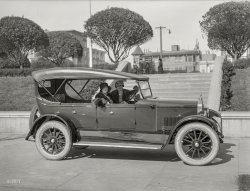
- A Feather in Her Cap: 1920
- San Francisco circa 1920. "Haynes touring car at de Young Museum, Golden Gate Park." Dapper flapper at the wheel, ... to take flight. Could this be our first photo by Chris Helin to portray someone famous? 5x7 glassneg. View full size.
Hint ... Posted by Dave - 06/12/2019 - 12:12pm -
![A Feather in Her Cap: 1920 San Francisco circa 1920. "Haynes touring car at de Young Museum, Golden Gate Park." Dapper flapper at the wheel, poised to take flight. Could this be our first photo by Chris Helin to portray someone famous? 5x7 glassneg. View full size.
HintBeethoven's Ninth, Gounod's Faust.
GuessMaybe Geraldine Farrar?
[Not metallic enough. -tterrace]
Another hintThe ghost of John McLaren is pleased that finding the famous is proving to be difficult.
The statues?Goethe and Schiller.
Dynamic duoAre you referring to the statue of Goethe & Schiller almost camouflaged by shrubbery at right?
When this photo was taken, the duo were located near the site of DeYoung Museum. Sometime in the 1920s they were evicted and moved across the Music Concourse to their present location next to the Academy of Sciences.
Could it be...Raymonde Delaunois , who sang in both?
[Not, it's those two guys below who wrote the words. -tterrace]
(The Gallery, Cars, Trucks, Buses, Chris Helin, San Francisco)](https://www.shorpy.com/files/images/SHORPY-1052.thumbnail.jpg)
- Dropping By: 1921
- San Francisco, 1921. "Maxwell Model 25 touring sedan." Honey, whose horse was that blocking the garage? 5x7 glass negative by Chris Helin. View full size.
I don't know, dear Ask Mrs. Kravitz next ... Posted by Dave - 07/10/2017 - 7:58pm -
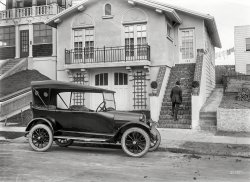
- The Happy Wanderer: 1918
- "Marmon touring car, San Francisco, 1918." Latest entry in the Shorpy Index of Ill-Fated Phaetons. 5x7 glass negative by Christopher Helin. View full size.
Interesting headlight lenses I wonder what ... motorcycles.
(The Gallery, Cars, Trucks, Buses, Chris Helin, San Francisco) ... Posted by Dave - 03/11/2016 - 10:56am -
![The Happy Wanderer: 1918 "Marmon touring car, San Francisco, 1918." Latest entry in the Shorpy Index of Ill-Fated Phaetons. 5x7 glass negative by Christopher Helin. View full size.
Interesting headlight lensesI wonder what purpose was served by the designs in the glass.
[They're Warner headlight lenses. Click to enlarge. -tterrace]
Warner DangerThe Warner-Lenz may have been "resistless", but judging by the list of car makers who adopted it, it was the Heisman Trophy of the auto industry!
Re: Warner LensesI believe there may be just the tiniest bit of exaggeration in the maker's claims.
New Car, Used (?) TiresCurious - the car appears to be new - dealer plates, clean undercarriage, shiny paint, with tires totally scraped and scuffed. Were new tires optional?
Amazing finishAlways amazed and the amazing paint finish and body panel fit on these early cars.
Maypop tiresThose tires look old and have messed up sidewalls. Why are they on this new-looking dealer car?
tterrace's advert for the headlight lenses lists the car companies carrying them as standard equipment. It is, in retrospect, not a promising list.
White Sidewall TiresThis is the first time I have noticed the tires had white sidewalls on both sides. Today, white sidewalls are only on one side. When did that change and why?
Headlight lensesI have a 1914 Hudson with Warner Lenz headlight lenses.
I just like the looks of them.
One of America’s bestI read a magazine article several years ago about the five greatest cars ever produced in America, and the 1931 Marmon was one of them (I think it was Brock Yates who wrote the article). They consistently made excellent automobiles until the Great Depression forced them to go out of business (just like Duesenberg and Stutz). Anyway, that stuck in my mind because I had never heard of Marmon before I read that article.
Marmon BusinessMarmon did get back into the transportation business, they were making trackless trolley coaches for Philadelphia, Pennsylvania's Rte. 66 on Frankford Ave. in 1955. Long ago, I think that they also made side cars for motorcycles.
(The Gallery, Cars, Trucks, Buses, Chris Helin, San Francisco)](https://www.shorpy.com/files/images/SHORPY-920.thumbnail.jpg)
- Sleeps Two: 1920
- San Francisco circa 1920. "Chalmers touring car on Eddy Street." Equipped with what seems to be a bed. 5x7 negative by Christopher Helin. View full size.
Who packed the shovel? Hank and Maggie off to ... Posted by Dave - 10/09/2014 - 6:02pm -
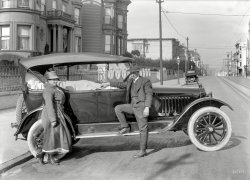
- Car & Drivers: 1919
- 1919. "Paige touring car at San Francisco Golf Club." When a Caddy just isn't enough. 5x7 glass negative by Christopher Helin. View full size.
Classy setting It looks like a scene from ... wheel.
(The Gallery, Cars, Trucks, Buses, Chris Helin, San Francisco) ... Posted by Dave - 02/01/2016 - 9:59pm -
![Car & Drivers: 1919 1919. "Paige touring car at San Francisco Golf Club." When a Caddy just isn't enough. 5x7 glass negative by Christopher Helin. View full size.
Classy settingIt looks like a scene from Downton Abbey.
Shingles Why do they look like they were put on by 8-year-olds?
[They're imitating the thatched roof on an English cottage. - Dave]
Bearly possibleThat appears to be an image of the California grizzly bear on the license plate, an homage to the short-lived Bear Flag Republic of 1846. Could that bear alternatively indicate that the car's owner is an alumnus of UC-Berkeley and its Cal Bears? I don't know whether association plates were offered that long ago.
[It's a star. Between 1916-1919 the image indicated the year of the plate's registration: 1916-bear; 1917-poppy; 1918-Liberty Bell; 1919-star. -tterrace]
Club house todayCurrent view of club house.
Car DoorsThose small doors make the Paige look even bigger. Easy to see why rear doors are small, but why didn't Paige make the front doors larger. Tight squeeze getting behind that steering wheel.
(The Gallery, Cars, Trucks, Buses, Chris Helin, San Francisco)](https://www.shorpy.com/files/images/SHORPY-889.thumbnail.jpg)























